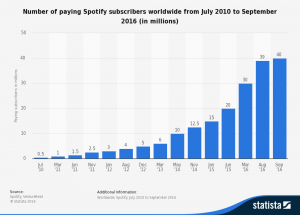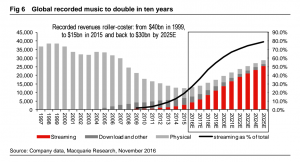The music industry has been known in recent years for declining at an extreme rate with no way of resurgence, but is it really declining? As a matter of fact, the music industry is steadily growing at a pace that no one expected, and that is all thanks to the massive streaming companies that are largely impacting the industry.
Justin Ng discussed in his blog about how iTunes download sales have been on the decline since its 2012 peak, dropping to a mere fraction in the coming years compared to what it once was. This may be true, but this doesn’t mean that revenue from the music industry in total is weakening. Earlier this year, Billboard reported that audio and video streams from streaming services were up a massive 58.7% compared to the same time last year. Not only that, but total album consumption had risen 8.9% compared to last year, for a total of 279.9 million units in the first half of 2016.
Streaming is primarily at hand for helping rescue the downslope of the music industry. Many streaming giants are thriving under these  circumstances, such as Spotify, Apple Music, Tidal, Pandora, and the newly-created Amazon Music, with numerous companies eager to invest in on the action. A majority of music labels are reporting increases in revenue due to streaming. UMG, for example, reported a 3.8% increase in overall revenue, from $3.9 billion to $4.02 billion.
circumstances, such as Spotify, Apple Music, Tidal, Pandora, and the newly-created Amazon Music, with numerous companies eager to invest in on the action. A majority of music labels are reporting increases in revenue due to streaming. UMG, for example, reported a 3.8% increase in overall revenue, from $3.9 billion to $4.02 billion.
For many artists and music labels, this means an increase in demand for music. Many consumers (including those who had previously illegally downloaded their music), are beginning to transition into the subscription services where they have the freedom to listen to whatever they please. Take into the account that Spotify and Apple Music are beginning to personalize their streaming services, while artists are making exclusive deals with these companies, and it’s no surprise that subscription counts are increasing at a massive rate year after year.
These results would mean promising results for the music industry in the future. Although Apple has seen a decline in iTunes, they have Apple Music to put much of their effort onto. Analysts have reported that in the 10 years, streaming will account for roughly 80% of the music industry’s revenue, a dramatic increase from its current 30%. as well as reporting double the current  music revenue from $15 billion to $30 billion in 2025, as customers turn to more subscription-based ways of accessing their music (primarily Spotify and Apple Music).
music revenue from $15 billion to $30 billion in 2025, as customers turn to more subscription-based ways of accessing their music (primarily Spotify and Apple Music).
It hasn’t only been North America that has seen this growth. Many other countries, such as Japan (the world’s second largest music market) have positively responded to these streaming services. This is a new age for music, and with increases in revenue, it looks like brighter skies ahead.
Word Count: 447
Bibliography: